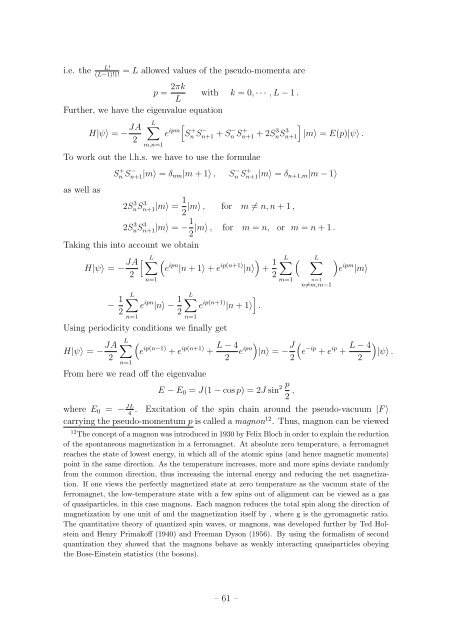Student Seminar: Classical and Quantum Integrable Systems
Student Seminar: Classical and Quantum Integrable Systems
Student Seminar: Classical and Quantum Integrable Systems
You also want an ePaper? Increase the reach of your titles
YUMPU automatically turns print PDFs into web optimized ePapers that Google loves.
i.e. the<br />
L!<br />
(L−1)!1!<br />
= L allowed values of the pseudo-momenta are<br />
p = 2πk with k = 0, · · · , L − 1 .<br />
L<br />
Further, we have the eigenvalue equation<br />
H|ψ〉 = − JA L∑<br />
]<br />
e<br />
[S ipm n + Sn+1 − + Sn − S n+1 + + 2S 3<br />
2<br />
nSn+1<br />
3 |m〉 = E(p)|ψ〉 .<br />
m,n=1<br />
To work out the l.h.s. we have to use the formulae<br />
as well as<br />
S + n S − n+1|m〉 = δ nm |m + 1〉 , S − n S + n+1|m〉 = δ n+1,m |m − 1〉<br />
2SnS 3 n+1|m〉 3 = 1 |m〉 , for m ≠ n, n + 1 ,<br />
2<br />
2SnS 3 n+1|m〉 3 = − 1 |m〉 , for m = n, or m = n + 1 .<br />
2<br />
Taking this into account we obtain<br />
H|ψ〉 = − JA [ ∑ L (<br />
)<br />
e ipn |n + 1〉 + e ip(n+1) |n〉 + 1 2<br />
2<br />
− 1 2<br />
n=1<br />
L∑<br />
e ipn |n〉 − 1 2<br />
n=1<br />
L∑<br />
n=1<br />
]<br />
e ip(n+1) |n + 1〉 .<br />
Using periodicity conditions we finally get<br />
H|ψ〉 = − JA L∑ (<br />
e ip(n−1) + e ip(n+1) + L − 4<br />
2<br />
2<br />
n=1<br />
From here we read off the eigenvalue<br />
L∑ ( ∑ L<br />
m=1<br />
)<br />
e ipn |n〉 = − J (<br />
2<br />
E − E 0 = J(1 − cos p) = 2J sin 2 p 2 ,<br />
n=1<br />
n≠m,m−1<br />
)<br />
e ipm |m〉<br />
e −ip + e ip + L − 4<br />
2<br />
)<br />
|ψ〉 .<br />
where E 0 = − JL . Excitation of the spin chain around the pseudo-vacuum |F 〉<br />
4<br />
carrying the pseudo-momentum p is called a magnon 12 . Thus, magnon can be viewed<br />
12 The concept of a magnon was introduced in 1930 by Felix Bloch in order to explain the reduction<br />
of the spontaneous magnetization in a ferromagnet. At absolute zero temperature, a ferromagnet<br />
reaches the state of lowest energy, in which all of the atomic spins (<strong>and</strong> hence magnetic moments)<br />
point in the same direction. As the temperature increases, more <strong>and</strong> more spins deviate r<strong>and</strong>omly<br />
from the common direction, thus increasing the internal energy <strong>and</strong> reducing the net magnetization.<br />
If one views the perfectly magnetized state at zero temperature as the vacuum state of the<br />
ferromagnet, the low-temperature state with a few spins out of alignment can be viewed as a gas<br />
of quasiparticles, in this case magnons. Each magnon reduces the total spin along the direction of<br />
magnetization by one unit of <strong>and</strong> the magnetization itself by , where g is the gyromagnetic ratio.<br />
The quantitative theory of quantized spin waves, or magnons, was developed further by Ted Holstein<br />
<strong>and</strong> Henry Primakoff (1940) <strong>and</strong> Freeman Dyson (1956). By using the formalism of second<br />
quantization they showed that the magnons behave as weakly interacting quasiparticles obeying<br />
the Bose-Einstein statistics (the bosons).<br />
– 61 –

















